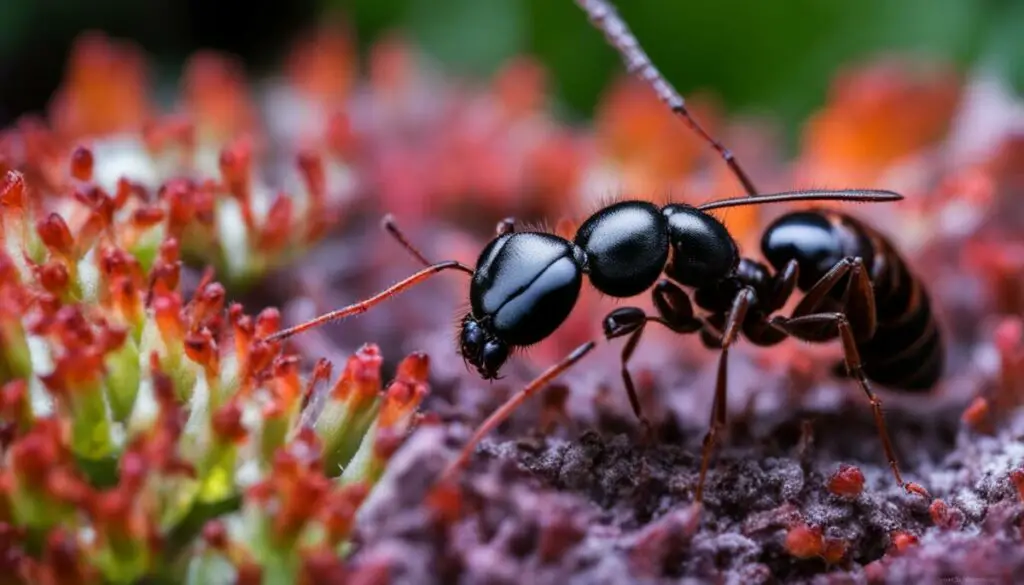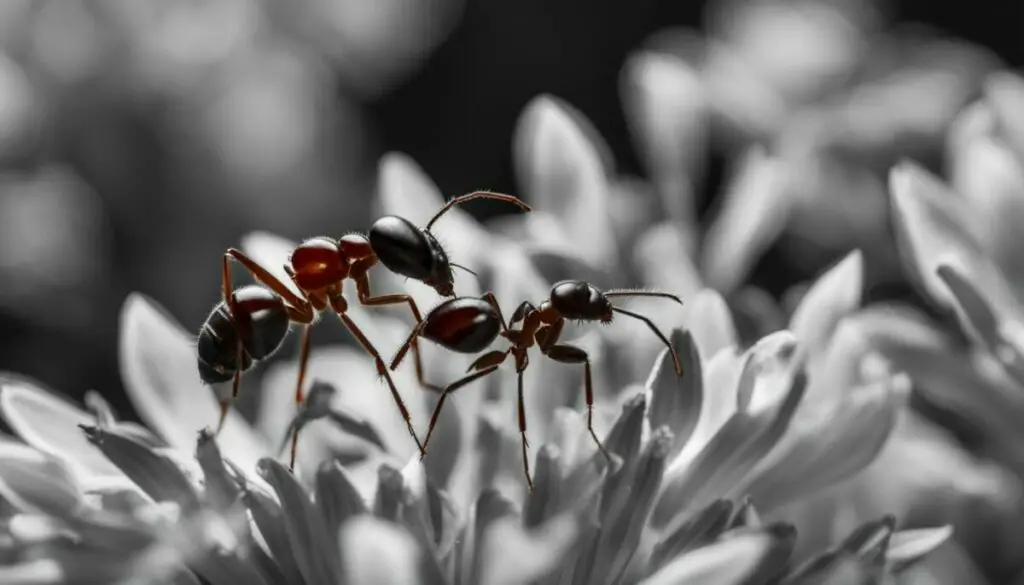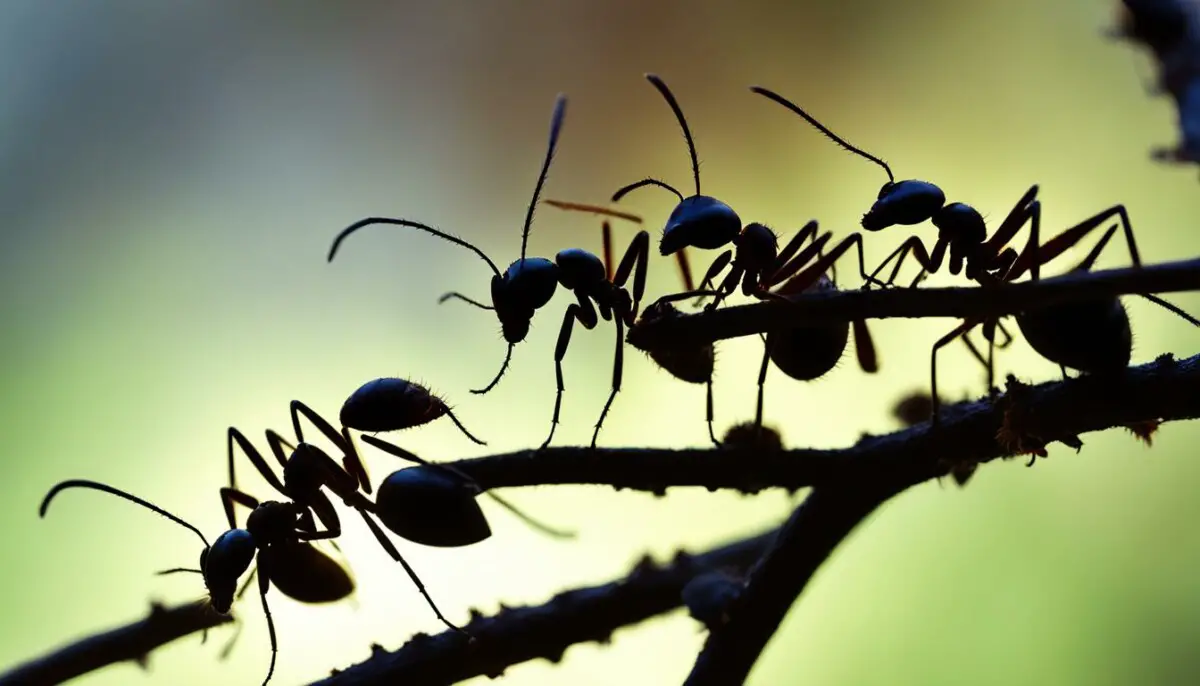Last Updated on 5 months by Francis
Ants are fascinating creatures with remarkable visual capabilities that play a crucial role in their navigation and perception. While some ant species have poorly developed eyes or are completely blind, others possess visual senses that extend beyond our human capabilities. One intriguing aspect of ant vision is their ability to detect and perceive infrared light, which opens up a whole new world of exploration and survival strategies.
Contents
Key Takeaways:
- Ants rely on visual cues for navigation and perception.
- Some ant species, like Camponotus fellah, can detect and perceive infrared light.
- Infrared detection helps ants navigate in dark or underground environments.
- Ants possess compound eyes and ocelli, which play different roles in their visual perception.
- The ability to perceive red light varies across different ant species.
Ants are highly skilled navigators, relying on a combination of sensory cues to explore their environment and locate valuable resources. Visual cues play a crucial role in assisting ants in their navigation, allowing them to navigate with precision and efficiency. While many ant species primarily rely on visual cues above ground, some ants possess the ability to see and detect infrared light, extending their visual capabilities beyond what humans can perceive.
Infrared sensing provides ants with the unique ability to perceive heat signatures, granting them an advantage in navigating dark or underground environments. By detecting infrared light, ants can effectively navigate in low-light conditions where other visual cues may be limited. This remarkable adaptation showcases the ingenuity of ants in utilizing available resources to enhance their navigation skills.
The integration of infrared perception with other sensory cues, such as chemical signals and self-referenced memories, allows ants to make informed navigational decisions. This combination of sensory information enables ants to adapt and overcome challenges in their constantly changing environment. By understanding the importance of visual navigation, including infrared sensory perception, scientists can gain valuable insights into the cognitive abilities of ants and potentially apply this knowledge to the development of advanced robotic vision systems.
| Ant Navigation | Visual Cues |
|---|---|
| Above ground navigation | Visual cues from the surrounding environment |
| Underground or dark environment navigation | Infrared sensing to perceive heat signatures |
| Integration of sensory cues | Combining infrared perception with chemical signals and self-referenced memories |
Overall, visual navigation, including the ability of ants to see infrared light, is a crucial aspect of their adaptive and ecological success. By leveraging visual cues and integrating them with other sensory information, ants can navigate their environment with precision and locate essential resources for the survival of their colonies.
The Role of Compound Eyes and Ocelli in Ant Vision

Ants possess remarkable visual capabilities, including the ability to detect and perceive infrared light. These visual abilities are facilitated by their unique compound eyes and ocelli. Compound eyes, which are found on the sides of their heads, allow ants to form an image of the world. While the resolution of their compound eyes is lower compared to human eyes, they are still able to detect movement and shapes in their environment.
In addition to compound eyes, ants also have smaller eyes called ocelli. These ocelli play a different role in their visual perception. Ocelli are responsible for detecting light levels and polarization, helping ants navigate and orient themselves in relation to the position of the sun. They provide ants with important information about their surroundings and contribute to their overall visual capabilities.
Some ant species, such as the Australian bull ants, have evolved to detect not only blue and green light but also ultraviolet light, including infrared light. This unique ability allows them to see a wider range of colors and detect heat signatures. By utilizing their compound eyes and ocelli, ants are able to navigate their environments and make informed decisions based on visual cues, including the perception of infrared light.
Ant Vision: A Combination of Compound Eyes and Ocelli
| Visual Organs | Role in Ant Vision |
|---|---|
| Compound Eyes | – Form an image of the world |
| – Detect movement and shapes | |
| Ocelli | – Detect light levels and polarization |
| – Aid in navigation and orientation |
Overall, the combination of compound eyes and ocelli allows ants to have a diverse and effective visual system. These visual organs enable ants to perceive infrared light, among other wavelengths, and navigate their environment with precision and adaptability.
Ants’ Sensitivity to Red Light

Ants exhibit varying levels of sensitivity to red light depending on their species. While some ants may have limited sensitivity to red light, larger species like Camponotus demonstrate the ability to detect and react to this specific wavelength. Unlike other light wavelengths, red light can be observed by researchers without disturbing ants as they may not perceive it as intensely. This makes red light an effective tool for studying ants’ behavior and movement without causing unnecessary disruption.
When using red light as an observation method, it is important to consider the specific species of ant being studied. Different ants have different visual capabilities and may respond differently to various light wavelengths. Researchers should also adjust the intensity of the red light to ensure that it is visible to the ants but does not overwhelm or disturb them.
Understanding ants’ sensitivity to red light provides valuable insights into their visual perception and can contribute to our overall understanding of their behavior and navigation strategies. By utilizing red light as a non-invasive observation method, researchers can gain a deeper understanding of ants’ interactions and movement patterns within their habitats.
The Diversity of Ant Vision

Ants display a remarkable diversity in their visual capabilities, with some species possessing the ability to detect and perceive infrared light. While certain ants have poorly developed eyes or are completely blind, others rely on visual cues, including infrared perception, for navigation and perception.
This variety in ant vision highlights the adaptability and survival strategies employed by different ant species in their respective habitats. Understanding the range of visual capabilities in ants sheds light on their cognition and behavior, providing valuable insights into their ecological success.
By studying ant vision, researchers can uncover how ants utilize infrared light to navigate in complex environments and make informed decisions. This knowledge not only enhances our understanding of animal cognition but also serves as inspiration for the development of robotic vision systems.
Table: Comparison of Ant Vision in Different Species
| Species | Visual Capabilities |
|---|---|
| Camponotus fellah | Ability to detect and perceive infrared light |
| Formica rufa | Well-developed compound eyes, limited infrared sensitivity |
| Atta cephalotes | Poorly developed eyes, rely on chemical cues more than visual cues |
| Camponotus consobrinus | Compound eyes with ultraviolet and infrared light sensitivity |
The diversity in ant vision not only showcases the vast range of sensory adaptations in the insect world but also highlights the importance of visual cues, including infrared perception, in ant navigation and survival.

Visual cues, including the detection of infrared light, play a crucial role in ant navigation. Ants have evolved to rely on their visual perception to navigate their environment, find food sources, and communicate with other members of their colony. Infrared detection, specifically, allows ants to sense heat signatures and temperature variations, which can be vital for locating resources or avoiding predators.
When ants navigate in the dark or underground environments, visual cues become even more important. While some ant species may have limited or no vision in such conditions, others, like the Malagasy ponerine ants, possess the remarkable ability to detect and perceive infrared light. This infrared vision enables them to navigate and orient themselves even in the absence of visual cues or in low-light conditions.
The integration of visual cues with other sensory information, such as chemical signals and gravitational cues, helps ants make informed navigational decisions. By combining infrared perception with their private memories and socially generated cues, ants can adapt and navigate effectively in changing environments.
| Ant Species | Visual Cues |
|---|---|
| Camponotus fellah | Infrared detection, self-referenced memories, socially generated chemical cues |
| Malagasy Ponerine Ants | Infrared detection, chemical signals, gravitational cues |
| Australian Bull Ants | Ultraviolet and infrared detection, blue and green light sensing |
Ants’ reliance on visual cues, including the detection of infrared light, highlights the remarkable adaptability and survival strategies of different ant species in their respective habitats. By studying how ants utilize these visual cues, scientists and researchers gain valuable insights into animal cognition and can apply this knowledge to advancements in robotics vision systems.
References:
- Hölldobler, B., & Wilson, E. O. (1990). The Ants. Harvard University Press.
- Land, M. F. (1997). The Roles of Ocelli in Insect Behaviour. In Sensory Systems Neuroscience. Springer.
- Yao, N., Mangan, M., & Webb, B. (2010). A Study on the Use of Visual Cues for Navigation by Ants. In Proceedings of the ACM/IEEE International Conference on Human-Robot Interaction, 401-402.

Ants’ ability to navigate in the dark or underground environments is reliant on their unique visual capabilities. While some ant species may have limited or no vision in low-light conditions, others, such as Camponotus fellah, possess the remarkable ability to detect and perceive infrared light. This infrared vision provides ants with the means to navigate and orient themselves in the absence of traditional visual cues, allowing them to successfully maneuver through dark and challenging environments.
Infrared perception plays a crucial role in ants’ navigation by helping them detect heat sources and temperature variations. This ability allows ants to find resources, locate nest entrances, and avoid potential threats, even when visibility is limited. By integrating infrared sensing with other sensory cues, such as chemical trails and gravitational signals, ants are able to make informed navigational decisions and ensure their survival.
The adaptation of ants to utilize infrared vision in their navigation is a testament to the remarkable diversity and adaptability of these tiny creatures. This unique visual capability provides insights into not only the sensory perception of ants but also potentially inspires advancements in robotics vision systems.
Ants rely on infrared vision to navigate in the dark or underground environments where traditional visual cues are limited. This infrared perception allows them to detect heat signatures, temperature variations, and other important features of their surroundings, enabling them to find food sources, communicate with other colony members, and avoid potential dangers. By utilizing this unique visual capability, ants showcase their remarkable adaptability and survival strategies in diverse habitats.
The integration of infrared sensing with other sensory cues, such as chemical trails and gravitational signals, enhances ants’ navigational abilities and helps them make informed decisions in changing environments. The combination of private cues, such as self-referenced memories, and social cues, such as chemical trails, further supports the efficient navigation of ants both above and below ground.
Overall, the utilization of infrared vision in ant navigation highlights the complexity and sophistication of these tiny creatures’ sensory perception. The study of ant vision not only provides valuable insights into animal cognition but also offers potential inspiration for the development of robotics vision systems.

Ants have evolved a remarkable system of navigation that relies on a combination of both private and social cues. Private cues include self-referenced memories and path integration, allowing ants to navigate based on their own previous experiences and movements. These cues help ants build mental maps of their environment and guide them towards familiar locations. Social cues, on the other hand, involve the release of chemicals by other ants, providing information about the environment and aiding navigation.
In addition to these cues, ants also possess the ability to detect and perceive infrared light, adding another layer to their navigation strategies. Infrared sensing allows ants to detect heat sources and temperature variations, providing valuable information for finding resources or avoiding predators. This ability plays a crucial role in situations where visual cues may be limited, such as in the dark or underground environments.
By integrating private cues, social cues, and infrared sensing, ants are able to adapt and navigate effectively in changing environments. This combination of cues allows ants to make informed decisions and ensures their survival and success as a collective. It is fascinating to observe how such small creatures utilize a complex system of cues to navigate their world.
Ants, like Camponotus fellah, rely on a variety of sensory cues to navigate their surroundings. While visual cues, including infrared perception, play a significant role in their navigation, ants also utilize gravitational signals to orient themselves along both the vertical and horizontal axes. These gravitational cues provide valuable information and help ants identify their position within the nest or the environment.
The ability to perceive and interpret gravitational signals allows ants to make informed decisions about their movement and behavior. By understanding the gravitational forces at work, ants can effectively navigate complex environments, find food sources, and avoid potential threats. This integration of gravitational signals with other sensory cues, such as infrared vision, enhances the ants’ overall navigation capabilities.
In addition to its role in ants’ surface navigation, the perception of gravitational signals is also crucial for underground navigation. Ants rely on these cues to establish a stable orientation and move through narrow tunnels or intricate underground structures. The ability to sense gravitational signals in combination with other sensory information, including infrared perception, enables ants to explore underground environments with precision and accuracy.
| Gravitational Signals in Ant Navigation | Surface Navigation | Underground Navigation |
|---|---|---|
| Role | Help ants orient themselves in relation to vertical and horizontal axes | Aid in establishing stable orientation and movement through tunnels and underground structures |
| Importance | Enhances overall navigation capabilities | Enables ants to explore underground environments with precision |
| Integration | Combined with other sensory cues, such as infrared perception | Combined with other sensory cues, such as chemical signals |
The role of gravitational signals in ant navigation showcases the complexity and sophistication of their sensory perception. By understanding how ants interpret and utilize these signals, scientists can gain insights into their cognitive abilities and apply these findings to various fields, such as robotics and artificial intelligence.

Ants possess remarkable visual capabilities, including the ability to detect and perceive infrared light. This unique sensory perception plays a crucial role in their navigation strategies. When faced with environmental changes or unexpected challenges, ants demonstrate a remarkable capacity for rapid learning and adaptation. They quickly adjust the weight attributed to different cues, including infrared perception, to improve their navigation performance and ensure their survival.
Ants’ ability to rapidly adapt within their visual capabilities, including heat vision and infrared detection, allows them to dynamically respond to their ever-changing surroundings. This adaptability is particularly evident when ants encounter obstacles, unfamiliar terrain, or changes in resource availability. By quickly adjusting their navigation strategies and prioritizing relevant cues, ants optimize their foraging efforts and increase their chances of success.
This rapid learning and adaptation in ant navigation can be attributed to several factors. First, ants rely on a combination of private and social cues. Private cues, such as self-referenced memories and path integration, guide ants based on their individual experiences. Social cues, including chemicals released by other ants, provide valuable information about the environment and help direct ants to desired locations. Additionally, the integration of visual cues, such as infrared perception, with other sensory information allows ants to make informed navigational decisions and overcome challenges.
In conclusion, ants’ ability to rapidly learn and adapt within their visual capabilities, including heat vision and infrared detection, enables them to navigate their complex environments effectively. This adaptability ensures the survival and success of ant colonies and serves as a valuable model for studying navigation and adaptation in other organisms. By understanding and harnessing the principles behind ants’ rapid learning and adaptation, researchers can gain insights into animal cognition and apply them to the development of robotics vision systems.
Ant Vision as a Model for Robotics
In recent years, researchers working on robotics vision systems have turned to ant vision as a source of inspiration. The remarkable visual capabilities of ants, including their ability to perceive infrared light, make them an intriguing model for developing robotic vision systems.
Ants’ compact and informative eyes, coupled with their capacity to detect a wide range of light wavelengths, offer valuable insights into the design and functionality of robotic vision systems. By studying how ants utilize infrared vision and integrate it with other sensory information, researchers can gain a deeper understanding of animal cognition and apply this knowledge to enhance the capabilities of robotic technologies.
Ant vision serves as a foundation for designing robotics vision systems that can navigate and perceive their surroundings more effectively. The ability to detect and perceive infrared light, similar to ants, can provide robots with a heightened awareness of their environment, especially in low-light or dark conditions. This capability has the potential to enhance robotic navigation and obstacle avoidance, allowing for improved performance and adaptability in various environments.
| Benefits of Ant-Inspired Robotics Vision Systems | Examples |
|---|---|
| Enhanced perception in low-light conditions | Robots equipped with infrared detectors can navigate effectively in dark environments, similar to ants. |
| Improved obstacle avoidance | Ants rely on visual cues, including the detection of heat signatures, to avoid obstacles. Robots can incorporate similar capabilities for enhanced obstacle avoidance. |
| Adaptability to changing environments | Ants demonstrate rapid learning and adaptation in their navigation strategies. Developing robots that can learn and adapt within their visual capabilities can enhance their overall performance. |
By drawing inspiration from ant vision, robotics researchers can unlock new possibilities for creating intelligent and adaptable robotic systems. Ants have evolved sophisticated visual capabilities, including the perception of infrared light, to navigate their complex environments. By integrating these capabilities into robotics vision systems, we can pave the way for advanced robots that can perceive and understand their surroundings with greater precision and efficiency.
Conclusion
Ants possess remarkable visual capabilities, including the ability to detect and perceive infrared light. While some ant species have poorly developed eyes or are completely blind, others rely on visual cues, including infrared perception, for navigation and orientation. Infrared sensing allows ants to detect heat signatures, navigate in the dark or underground environments, and make informed navigational decisions.
The diversity of ant vision highlights the adaptability and survival strategies of different ant species. By studying and understanding ant vision, researchers can gain insights into animal cognition and develop robotic vision systems.
Overall, the ability of ants to see infrared light expands their visual capabilities and enhances their navigation and perception skills. This unique adaptation contributes to the adaptive success of ant colonies and provides researchers with valuable insights for further advancements in the field of robotics.
FAQ
Can ants see infrared light?
Yes, certain ant species, such as Camponotus fellah, have the ability to detect and perceive infrared light.
Ants rely on visual cues, including infrared perception, to navigate their environment, find food sources, and communicate with other members of their colony.
What role do compound eyes and ocelli play in ant vision?
Compound eyes allow ants to form a low-resolution image of their surroundings, while ocelli help ants detect light levels and polarization, aiding in navigation and orientation.
Can ants see red light?
Some ant species, particularly larger ones like Camponotus, have the ability to detect and react to red light, although sensitivity may vary between species.
Do all ants have the same visual capabilities?
No, ants possess a range of visual capabilities that vary across different species, with some ants having poorly developed eyes or being completely blind.
Ants like Camponotus fellah rely on self-referenced memories, socially generated chemical cues, and the ability to sense infrared light to navigate in the dark or underground environments.
Ants utilize a combination of private cues, such as self-referenced memories, and social cues, including chemicals released by other ants, to navigate their surroundings.
Yes, ants demonstrate rapid learning and adaptation in their navigation strategies, adjusting the weight attributed to different cues, including infrared perception, when faced with environmental changes or challenges.
Gravitational cues help ants orient themselves along the vertical and horizontal axes, allowing them to identify their position within the nest or environment.
Can ant vision be applied to robotics?
Ant vision, including the ability to perceive infrared light, has inspired researchers working on robotics vision systems, as understanding ant vision can contribute to the development of robotic technologies.









